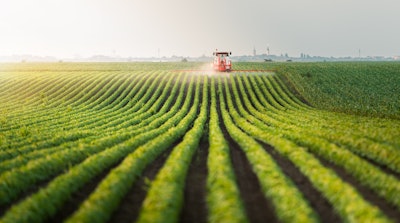
Climate change is here, and its impacts on the global food supply chain are already visible. Nations have set ambitious and necessary targets with the Paris Agreement, but with or without it, we’re already locked into a path for the next two decades that includes at least 1°C of warming — an extreme that humans have never seen before. The infrastructure built to transfer goods and products around the world isn't prepared.
Much of that infrastructure has been honed in the past few decades to prioritize efficiency — think lean manufacturing, etc. But, the relentless pursuit of efficiency has led to low inventories and choke-points. Climate change demands a new paradigm that builds resilience over efficiency.
Increasingly, companies are under pressure from their customers, partners and stakeholders to address climate risks in both day-to-day operations and long-term strategies. Luckily, with advancements in climate science and technology, companies across the food supply chain can better understand their exposure, vulnerabilities and potential losses. With this information, they can boost resilience and turn these risks into opportunities to improve transparency and increase profitability.
Understanding climate risk with technology-enhanced forecasting
With trends such as “just-in-time” models that minimize inventory and increase efficiency, unexpected climate change-related events can disrupt operations. We need better ways to not only expect the unexpected, but also prepare for it.
No one can predict the future, but we can forecast it. Having reliable forecasts of production volumes is crucial for every business’ decisions on a variety of time scales. Seasonally, farmers need to know what crop yields to anticipate in order to meet contracts, while retailers need to know what quality inventory to expect in order to cater to changing consumer tastes. Longer term, businesses need to think about what type of physical infrastructure to invest in, or how to most successfully plan to expand their businesses in the next decade.
Climate change complicates these decisions. Historical averages that we’ve relied upon to forecast weather, yields, quality and other key metrics are no match for increasing climate variability. Once-in-100-year storms are happening every 10 years. Nearly every year has been hotter than the one before for the past 20 years. Conventional forecasting can’t keep up.
New advancements in forecasting have been able to provide more accurate, reliable climate forecasts, which translate into production volume forecasts that can inform business-critical decisions.
Artificial intelligence advancements enable a new approach to forecasting, which allows models to simulate patterns back for centuries and take into account climate change’s impacts. In addition, it uses big data from both industry and public sources to create place-based, crop-specific and industry-focused predictions. The delivered results are more reliable than conventional models and can be run on a laptop, whereas in the past, they required supercomputers.
With more accurate forecasts, businesses can better understand both short-term and long-term climate risks, prepare for these shocks and optimize their supply chains accordingly.
Managing climate disruptions through supply chain traceability and optimization
One major tool for companies is supply chain mapping. The process involves collecting data and creating a full picture of companies within their supply chain at every stage.
In the food sector, this transparency and traceability is especially important because safety is crucial. Mapping can also help companies identify supply chain efficiencies, comply with regulatory requirements and tell the story of their products to consumers.
It can also reveal vulnerabilities to climate shocks — for example, one product might come from suppliers that are concentrated in a single geography, perhaps due to that country’s climate and specialization. However, that would signal vulnerability — if a natural disaster struck that part of the world, there could be critical shortages that would affect upstream.
In Madagascar, for example, the world capital of vanilla production, a drought has induced crop failure and tragic famine. Nearly 75% of farmers aren’t able to feed themselves or their families. When one link in the chain breaks, the rest of the supply chain feels it.
In addition, back-up suppliers are often from the same region, so the risk is not properly dispersed. Traceability technologies like the Internet of Things (IoT) track exactly where parts and goods originate, giving greater insight into the vulnerabilities. Smart inventory management software can also help companies enhance their flexibility — staying efficient but resilient.
Turning climate risk into opportunity to increase profitability
Companies can take action to make their supply chains resilient using short-term and long-term climate forecasting to identify vulnerable geographies, crops, trade routes and facilities. Companies can use this intelligence to diversify their suppliers, expand into new regions with less risk or build redundancy into their operations.
Other use cases include decisions around physical assets. If storage facilities or processing plants are in regions experiencing above-average rising temperatures, heat exposure for workers poses a risk. Those facilities will need new cooling systems to be installed to prepare fully for rising temperatures. Companies that have infrastructure in regions that are increasingly vulnerable to worsening hurricanes or to sea level rise will need storm surge backup plans. That could involve installing bulkheads, elevating critical machinery and utility equipment, adding more waterproof sealing, reworking drainage and valves or abandoning the buildings altogether.
Companies will also need to build more flexibility and redundancies into their transportation and logistics. The Coronavirus disease (COVID-19) pandemic has led to global shipping catastrophes already. Climate disruptions will cause similar issues, but forward-thinking companies can establish alternatives.
Acting now to stay ahead
Long-term global warming trends, from rising temperatures, more frequent and severe extreme weather and sea level rise pose never-before-seen costly material risks to companies across food supply chains and to food security overall.
Businesses are already experiencing more disruptions than before. Consider that over the past few years, higher temperatures and less rainfall have meant more evaporation and lower water levels in the Panama Canal, one of the world’s most critical commodities trade routes. In the United States last year, Midwestern derechos affected nearly 50% of the 24.7 million acres of corn and soybean planted in Iowa alone, not to mention the damage to local storage and processing facilities. And this summer, Brazil has seen its worst drought in a century, accelerated by climate change, leading to shortages and inflation of commodities like sugar, which hit a four-year high in August.
According to McKinsey, companies can now expect supply chain disruptions lasting a month or longer to occur every 3.7 years on average across industries, with the most severe events causing major financial losses. In addition, 2020 had the most billion-dollar extreme weather events of any year in the United States alone, with 22 events costing upwards of $95 billion.
Investing in climate risk management systems is crucial for business continuity in the coming years as climate change continues to worsen. New digital tools can provide solutions for supply chain transformation and optimization. With enhanced analytics, actionable decision-making metrics, connected suppliers and traceable products, companies can recover from disruptions more quickly than their competitors. Companies can no longer afford to not invest in resiliency.

















